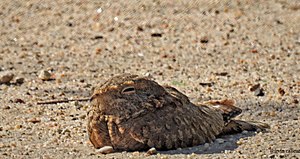Pharaohs goat milkers
| Pharaohs goat milkers | ||||||||||
|---|---|---|---|---|---|---|---|---|---|---|

Pharaohs goat milkers |
||||||||||
| Systematics | ||||||||||
|
||||||||||
| Scientific name | ||||||||||
| Caprimulgus aegyptius | ||||||||||
| Lichtenstein , 1823 |
The Pharaoh's goat milker ( Caprimulgus aegyptius ) or Egyptian goat milker is a 25 centimeter tall representative of the nightjar family .
Appearance
These birds have very light, sandy-colored plumage. The belly and throat are white. The beak with long, bristly feathers and the legs are black. The wings are colored black towards the end and the tail is provided with black smaller spots. The plumage color serves the birds as a camouflage from predators. The only difference between the sexes are the tail feathers, which are sand-colored in the male.
Distribution and way of life
This species occurs in North Africa , there especially in Egypt and in Southwest Asia. Outside the breeding season it can also be found in Sudan and Central Africa . There it can usually be found near the edges of the forest. In addition, the Pharaoh's goat milker stays near large herds of camels, horses, goats or sheep from human settlements. There he looks for insects that he catches in flight. Its long, bristle-like feathers on its beak serve as a catch for insects. These nocturnal animals usually hide under bushes or stones during the hot day. Life expectancy is around 6 years.
Reproduction
During the courtship season, the male performs a very acrobatic flight by clapping his wings together. To do this, he utters a “kre-kre-kre” or a similar sounding call. The female lays 2 pink, gray and red-brown spotted eggs in the nest, just a shallow hollow in the floor. The female usually takes on the breeding business all by herself. It is only released from the male during the short time it searches for food. The young hatch after 16-18 days. Both parent animals provide the young with insects. If their offspring is threatened by predators, the parent animals perform a sensational, multiple nosedive to lure enemies away from the nest. At the age of 19 days the young leave the nest with plumage dotted for camouflage. However, they will be provided with food by their parents for up to two more weeks.
Hazards and protective measures
Although the number of individuals of this species is decreasing, it is still very numerous and widespread. Therefore, it is still classified by the IUCN as ( Least Concern ) not endangered.
literature
- Jiří Felix (eds.), Jaromír Knotek, Libuše Knotková: African fauna in color. Translated from the Czech by Roland Schür. Karl Müller Verlag, Erlangen 1989, pp. 247–248.
- Christopher M. Perrins (Ed.): The FSVO encyclopedia birds of the world. Translated from the English by Einhard Bezzel . BLV, Munich / Vienna / Zurich 2004, ISBN 978-3-405-16682-3 , pp. 336–339 (title of the original English edition: The New Encyclopedia Of Birds. Oxford University Press, Oxford 2003).
Web links
- Caprimulgus aegyptius inthe IUCN Red List of Threatened Species 2018.2. Listed by: BirdLife International, 2018. Retrieved December 12, 2018.
- Pharaoh nightjar feathers

